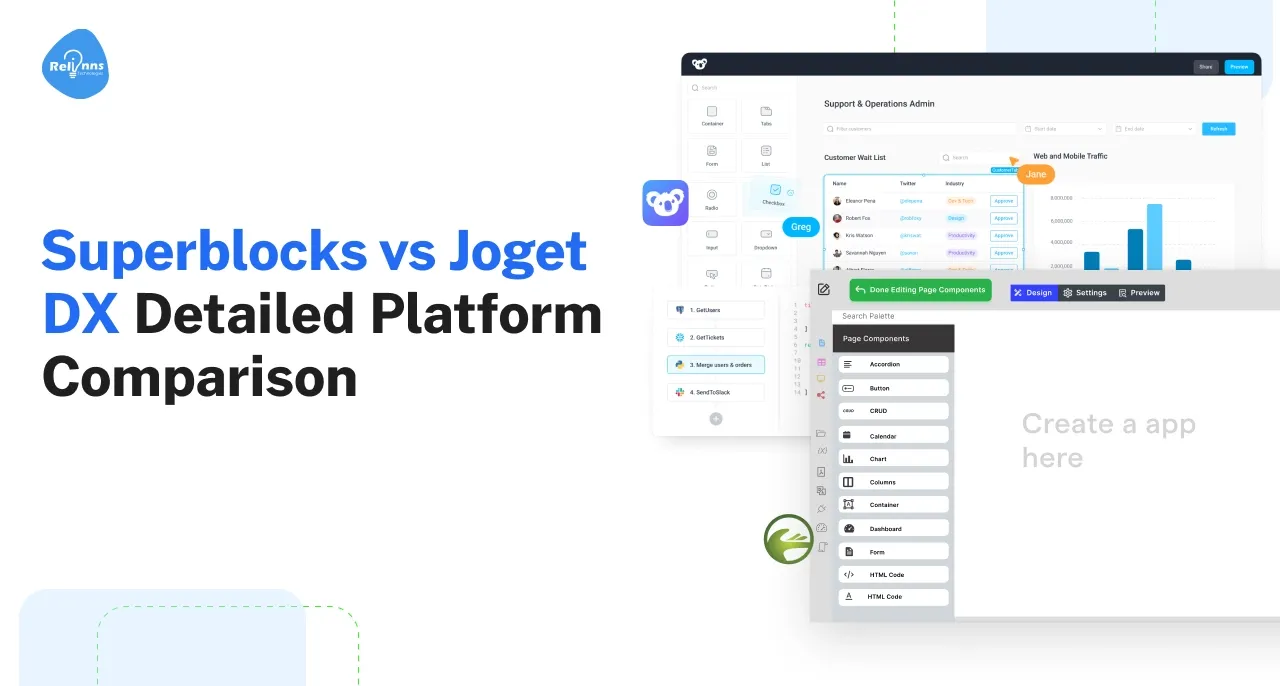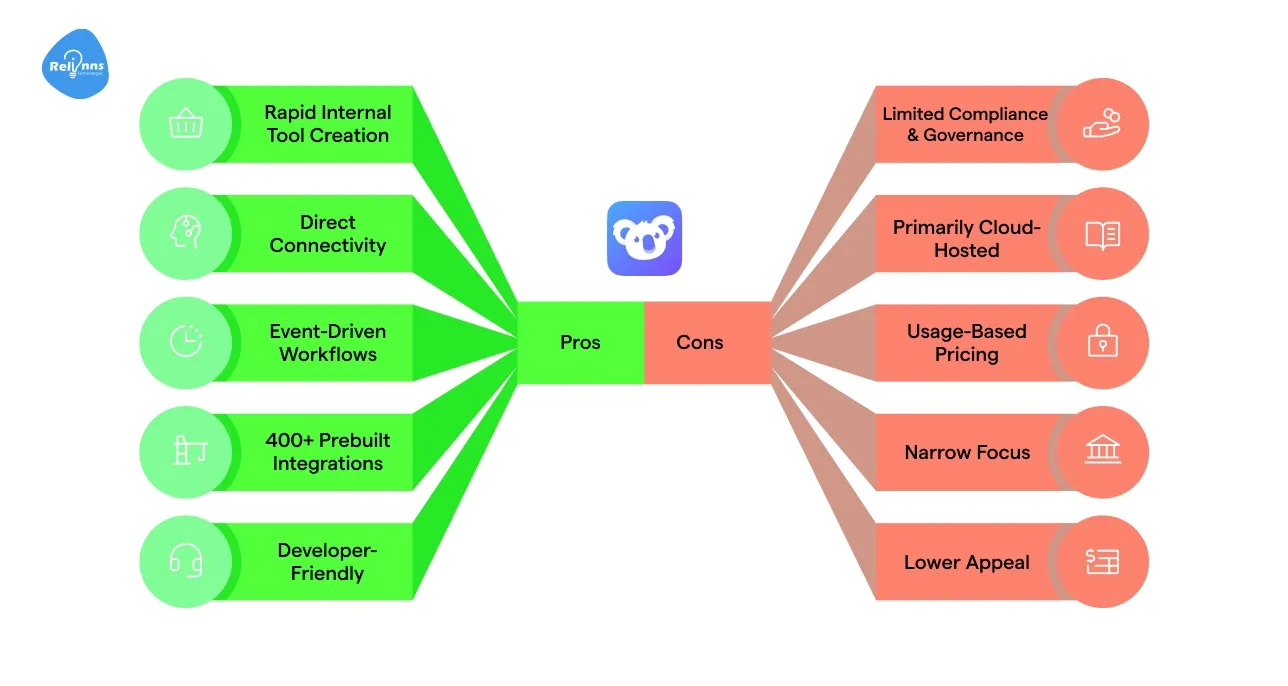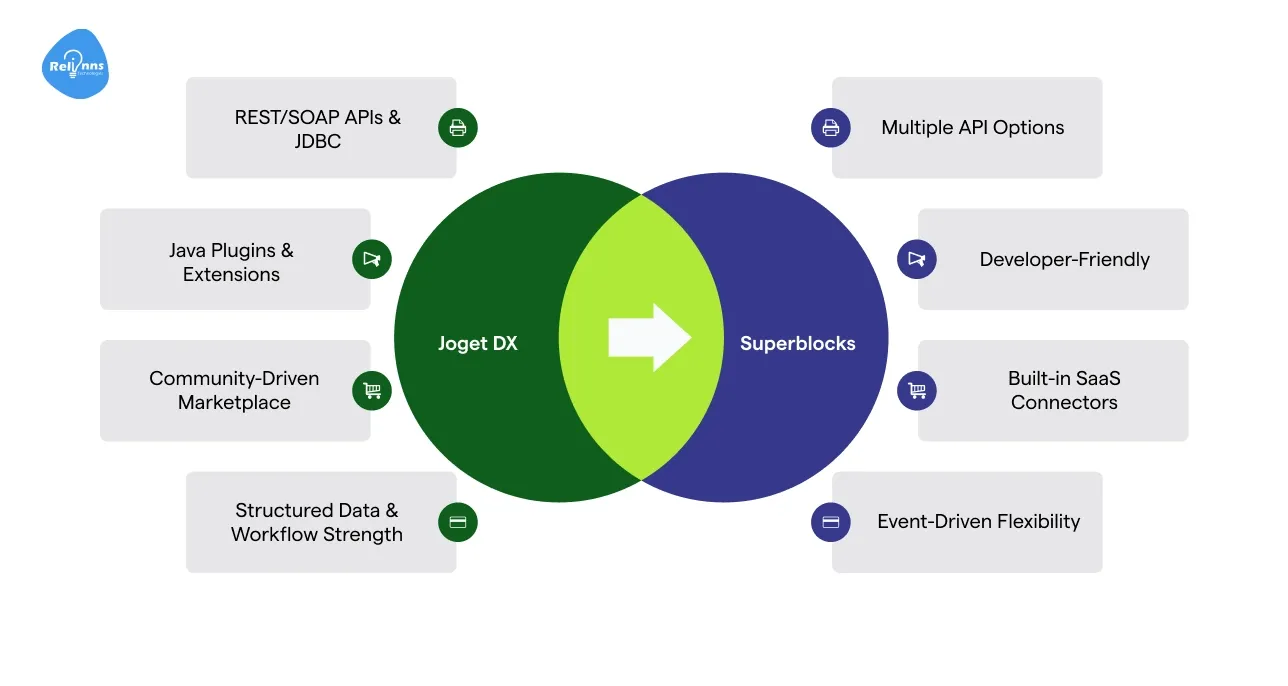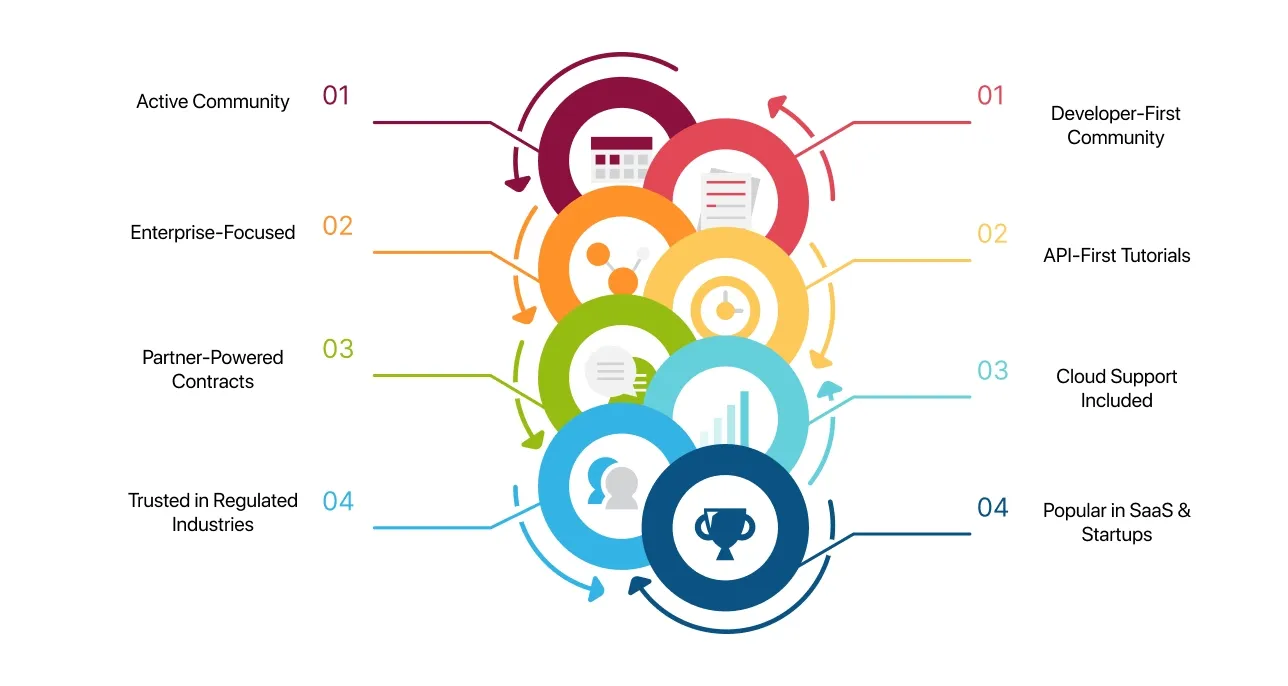Superblocks vs Joget DX Detailed Platform Comparison
Date
Sep 22, 25
Reading Time
8 Minutes
Category
Low-Code/No-Code Development

Low-code adoption is reshaping modern enterprises, allowing IT and business teams to deliver applications faster with fewer resources.
The Superblocks vs Joget debate has gained momentum as organizations seek platforms that balance speed, governance, and extensibility.
Joget DX positions itself as a genAI, enterprise-grade low-code platform, providing full-stack app development, compliance certifications, and deployment flexibility across cloud, on-premises, and hybrid environments. Check out our comprehensive guide on Joget to learn more.
Superblocks, on the other hand, is designed for internal tools and API-driven applications, offering developers rapid drag-and-drop interfaces connected directly to databases and services.
This Superblocks vs. Joget DX Comparison explores their core differences in features, scalability, compliance, pricing, and real-world use cases.
By the end, you’ll understand which tool best suits your needs: Joget DX for enterprise structure and governance, or Superblocks for developer-led agility in building internal applications.
What are Superblocks?

Superblocks is a developer-focused low-code platform designed primarily for building internal tools and API-driven applications.
Unlike full-stack enterprise solutions, it emphasizes speed and flexibility for engineers who need to assemble operational dashboards, workflows, and admin panels with minimal overhead.
Superblocks connects directly to databases, REST APIs, and GraphQL services, enabling developers to combine backend logic with front-end components through a drag-and-drop interface.
It is powerful in internal use cases such as customer support portals, analytics dashboards, and workflow management tools.
App Development Features Comparison: Superblocks vs Joget
The Superblocks vs. Joget debate highlights two very different philosophies of low-code development.
Joget DX is built as a comprehensive enterprise application platform, while Superblocks is engineered for developer-led internal tool creation.
Key Differences: Superblocks vs Joget
When analyzing Superblocks vs Joget, the contrast lies in their design philosophy. Joget DX is an enterprise-first solution, delivering governance and full-stack applications. Superblocks is developer-first, enabling rapid construction of internal tools.
| Factor | Joget DX | Superblocks |
| Core Focus | Full-stack enterprise app development | Internal tools & API-driven apps |
| Target Users | IT teams, regulated industries, compliance-heavy orgs | Engineering teams, SaaS startups, ops teams |
| Customization | Plugins, Java extensions, REST APIs | SQL queries, REST, GraphQL, scripts |
| Deployment | Cloud, on-premises, hybrid | Primarily cloud-hosted |
| Compliance | ISO 27001, SOC 2, GDPR-ready | Limited compliance emphasis |
| Pricing | Transparent per-user licensing | Usage-based cloud pricing |
Rather than asking which is “better,” the real Superblocks vs. Joget DX Comparison reveals where each tool thrives: Joget in enterprise-scale governance, and Superblocks in lightweight internal development speed.
Pros and Cons: Superblocks vs Joget
The joget vs Superblocks evaluation highlights very different strengths.
Joget DX provides a structured platform for developing full-stack enterprise applications, whereas Superblocks is designed for developer-led internal tool building.
Pros and Cons of Joget DX
Joget DX is enterprise-ready with governance and compliance features, but it can feel heavier for teams only needing lightweight internal applications.
| Pros | Cons |
| Transparent pricing starting at $5–17/user/month, depending on plan | Smaller SaaS connector library compared to Superblocks |
| End-to-end enterprise app development (forms, workflows, dashboards) | Higher IT involvement is required for advanced extensions |
| Flexible deployment: cloud, hybrid, or on-premises | Less suited for rapid prototypes of internal tools |
| Compliance-ready with ISO 27001 and SOC 2 | Limited marketplace compared to larger ecosystems |
| Free for three users on shared cloud plans | Steeper learning curve for non-technical users |
Pros and Cons of Superblocks

Superblocks focuses on API-first development and fast internal tool delivery, though it lacks some enterprise governance capabilities found in Joget DX.
Pros | Cons |
| Rapid internal tool creation for startups and engineering teams | Limited compliance certifications and governance |
| Direct SQL, REST, and GraphQL connectivity | Primarily cloud-hosted, with fewer hybrid options |
| Event-driven workflows and scripting flexibility | Usage-based pricing may escalate with heavy workflows |
| 400+ prebuilt integrations for SaaS and databases | Narrow focus on internal apps vs enterprise-wide systems |
| Developer-friendly with scripting and automation logic | Less appeal for regulated industries |
In the Superblocks vs. Joget DX Comparison, Joget leans toward regulated industries needing compliance, while Superblocks delivers speed for API-driven internal tools.
Suggested Reading: Joget DX vs Elegere: Comparison of Low-Code Tools
A. Scalability and Performance: Superblocks vs Joget
Scalability is a key distinction in the Superblocks vs Joget debate.
Joget DX scales through clustering with Docker and Kubernetes, making it reliable for enterprise workloads.
Superblocks focuses on scaling internal applications and workflows through its cloud infrastructure.
Factor | Joget DX | Superblocks |
| Scaling Model | Clustered deployments with Kubernetes | Cloud-native scaling for internal tools |
| Target | Enterprise-grade applications | Departmental and startup internal apps |
| Resource Use | Heavier infrastructure, but predictable | Lightweight, scales automatically in the cloud |
| Performance Focus | Long-running enterprise workflows | Event-driven automation and fast execution |
B. Integration and Extensibility: Superblocks vs Joget

The joget vs Superblocks comparison highlights different integration styles.
Joget relies on plugins, REST APIs, and JDBC for database and system connectivity, while Superblocks emphasizes direct API-first integration with SQL, REST, and GraphQL.
Factor | Joget DX | Superblocks |
| Connectors | REST/SOAP APIs, JDBC, plugins | SQL, REST, GraphQL, SaaS APIs |
| Extensibility | Java plugins, marketplace extensions | Developer scripting and custom endpoints |
| Ecosystem | Community-driven marketplace | Built-in SaaS connectors |
| Data Handling | Strong for structured data and workflows | Flexible for event-driven data and APIs |
C. Customization and Development Speed: Superblocks vs Joget
Customization in Superblocks vs. Joget DX Comparison is about enterprise depth vs developer agility.
Joget offers low-code prototyping with plugin support, while Superblocks allows faster internal app creation with scripting flexibility.
Factor | Joget DX | Superblocks |
| Development Style | Visual app builders + low-code extensions | Drag-and-drop UI with scripting logic |
| Speed | Faster for enterprise-grade apps | Faster for lightweight internal tools |
| Flexibility | Full-stack customization for IT teams | Agile, API-driven for developers |
| Ideal Use | Complex business applications | Quick prototypes and SaaS integrations |
D. Security and Compliance: Superblocks vs Joget

Security is another point of divergence in the Superblocks vs. Joget DX comparison.
Joget comes with ISO 27001 and SOC 2 certifications, while Superblocks is more developer-focused and less compliance-oriented.
Factor | Joget DX | Superblocks |
| Development Style | Visual app builders + low-code extensions | Drag-and-drop UI with scripting logic |
| Speed | Faster for enterprise-grade apps | Faster for lightweight internal tools |
| Flexibility | Full-stack customization for IT teams | Agile, API-driven for developers |
| Ideal Use | Complex business applications | Quick prototypes and SaaS integrations |
E. Support and Community: Superblocks vs Joget

In the N8N vs. Joget DX style of comparison, community and support often shape adoption.
Joget has both an open-source community and enterprise support, while Superblocks offers documentation and developer-first support channels.
Factor | Joget DX | Superblocks |
| Community | Active open-source and enterprise forums | Developer-first community and resources |
| Documentation | Detailed, enterprise-focused | Developer-oriented, API-first tutorials |
| Support | Paid enterprise contracts via partners like Relinns | Cloud support is included with plans |
| Adoption | Popular in regulated industries | Growing in SaaS and startup circles |
Use Cases: Superblocks vs Joget
Features can highlight possibilities, but real implementations reveal how platforms respond to complex business demands.
In the Joget vs Superblocks debate, case studies show apparent differences in where each tool thrives.
A. Supply Chain Management — Joget DX Use Case
Problem: A Sweden-based logistics provider faced challenges in shipment visibility, manual scheduling, and fragmented carrier integrations. Rapid growth created issues with scalability, a lack of predictive alerts, and miscommunication between admins, agents, and drivers. These bottlenecks slowed delivery, reduced accuracy, and hurt customer satisfaction.
Solution: Relinns implemented a Joget DX–based supply chain management platform. The solution introduced modular development, real-time GPS sync, AI-driven route optimization, role-based dashboards, and instant exception alerts. By consolidating carrier data and scaling infrastructure, the system enabled smooth operations and complete lifecycle transparency.
Results
- 54% faster shipment processing, cutting delivery planning and fulfillment time nearly in half.
- 95% on-time delivery accuracy, with predictive exception alerts, preventing SLA breaches.
- 3x increase in dispatcher dashboard usage and higher agent productivity through unified workflows.
- 28% downtime reduction, boosting resource efficiency across the network.
- Customers gained real-time shipment tracking, improving transparency and trust.
This demonstrates how Joget DX can transform logistics operations by enhancing speed, scalability, and visibility across global supply chains.
Read more about the case study here: Relinns Supply Chain Management Case Study
B. Internal Tools for SaaS Teams — Superblocks Use Case
Problem: A high-growth SaaS company faced mounting challenges in managing customer data across multiple systems like PostgreSQL, Salesforce, and third-party analytics. Developers were overwhelmed with requests for new dashboards, customer success teams lacked real-time insights, and sales operations struggled to consolidate performance metrics. Traditional development methods were too slow to keep pace with the demands of scaling operations.
Solution: Using Superblocks, the company’s engineering team built a suite of internal-facing applications tailored for customer success and sales ops. Superblocks’ direct integration with SQL databases and APIs enabled developers to connect live data without the need for lengthy backend builds. Teams could view and update customer information, monitor KPIs, and trigger automated processes such as renewal alerts and account escalations—all within a single dashboard.
Results
- Dashboards were delivered in weeks, not months.
- Backlog dropped as teams used Superblocks apps.
- Sales gained faster access to live customer metrics.
- Successful managers improved account tracking and retention.
Read more about the case study here: Superblocks Customer Success Stories
This Superblocks vs. Joget DX Comparison highlights how Superblocks empowers developer-driven teams to quickly deliver operational tools, while Joget focuses on long-term transformation in regulated industries.
Pricing Comparison: Superblocks vs Joget
Pricing plays a central role in the joget vs Superblocks evaluation, especially as organizations weigh predictable licensing against usage-based flexibility.
Joget DX follows a tiered per-user pricing model.
Plans start at $5/user/month for small groups, $10/user/month for larger teams, and scale up to $17/user/month for clustered enterprise environments.
All editions include unlimited workflows, and the shared cloud tiers remain free for three users after the trial. This makes Joget particularly appealing to enterprises that value cost predictability and transparent licensing.
Superblocks, on the other hand, uses a usage-based pricing model.
Its free plan covers limited executions, while paid tiers expand based on API calls, workflow runs, and developer seats.
This flexibility is ideal for startups or teams building internal tools, but it can result in cost escalation as workloads scale, making it less predictable than Joget.
Plan / Tier | Joget DX | Superblocks |
| Free | Community Edition, free for 3 users after trial | Free tier with limited executions |
| Starter | $5/user/month (5–25 users) | Usage-based pricing, limited seats |
| Standard | $10/user/month (5–100 users) | Paid tiers scale with API calls & workflows |
| Enterprise | $13–17/user/month (100+ users, clustered) | Enterprise plans tailored for large teams |
| Cost Predictability | Fixed per-user licensing | Variable, tied to usage |
In the Superblocks vs. Joget DX Comparison, Joget offers transparent and predictable pricing, while Superblocks provides flexibility but less cost certainty as workloads increase.
Which Tool is Best for Your App Development?
The decision between joget vs Superblocks depends on whether your priority is enterprise governance or developer speed.
Joget DX is the stronger choice for organizations needing full-stack enterprise applications that cover forms, workflows, dashboards, and compliance.
Its governance-ready approach, combined with deployment flexibility across cloud, hybrid, and on-prem environments, makes it ideal for regulated industries such as healthcare, finance, and government.
Superblocks is best suited for developer-driven teams that need to build internal tools and dashboards quickly. By connecting directly to SQL databases, REST APIs, and SaaS services, it allows engineers to roll out customer success apps, sales dashboards, and admin panels at speed without heavy IT involvement.
In a Superblocks vs. Joget DX comparison, Joget stands out for enterprises requiring structured application delivery. At the same time, Superblocks excels in agile environments where time-to-market for internal tools is critical.
Final Thoughts on Superblocks vs Joget
The Superblocks vs Joget DX comparison highlights two fundamentally different approaches to low-code. Joget DX is designed as a comprehensive enterprise platform that balances rapid development with governance, compliance, and scalability. It is the better fit for organizations where business-critical applications must align with regulatory standards and long-term IT strategies.
Superblocks, by contrast, is built for developer speed and operational agility. It excels at connecting APIs and databases into internal tools that empower teams to act faster. For startups and SaaS-focused businesses, this means less time waiting on IT backlogs and more time delivering operational value.
Ultimately, the choice between joget vs Superblocks depends on whether your roadmap emphasizes enterprise-grade stability or lightweight internal innovation. Both platforms deliver value, but each answers a different set of organizational needs.
Why Choose Relinns for Joget?
- Faster deployment cycles with up to 70% reduction in delivery timelines.
- Work with Joget developers officially certified by Joget’s team.
- Custom plugin development for extending Joget’s marketplace ecosystem.
- Hands-on support for hybrid and on-premises enterprise deployments.
- Deep focus on compliance, with solutions designed for regulated industries.
Frequently Asked Questions (FAQ's)
How does joget vs Superblocks differ in handling compliance-heavy industries?
Joget DX offers ISO-certified governance features for regulated sectors, whereas Superblocks focuses more on developer agility for internal applications without extensive compliance frameworks.
Can Superblocks vs Joget platforms be integrated into a single enterprise strategy?
Yes. Many companies deploy Joget DX for enterprise-grade applications, while using Superblocks for lightweight internal dashboards, thereby blending governance with fast, developer-led tools.
What does the Superblocks vs. Joget DX Comparison show about customization flexibility?
Joget supports plugins, Java APIs, and low-code extensions, making it suitable for IT-heavy needs. Superblocks emphasizes SQL queries, REST endpoints, and scripting for agile customization.
Which teams benefit most from joget vs Superblocks implementations?
Joget DX suits IT and compliance-driven organizations, such as healthcare or finance, while Superblocks caters to SaaS teams, sales operations, and startups seeking rapid internal tool delivery.
How does pricing vary in Superblocks vs Joget DX models?
Joget follows predictable per-user monthly pricing across tiers, while Superblocks uses usage-based pricing tied to API calls, workflows, and executions, which can fluctuate depending on activity levels.
Is Superblocks vs. Joget DX suitable for long-term scalability?
Joget DX scales through Kubernetes clusters for enterprise workloads, whereas Superblocks scales cloud-based workflows, making it better for teams focused on integration-heavy internal processes.


